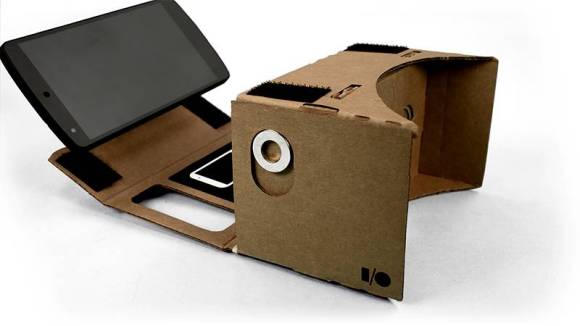
In June 2014, Google revealed a low-cost Smartphone Adapter and VR SDK at their annual software developer conference in San Francisco, California. During the event, Google handed out 6,000 cardboard kits and released a tutorial online, which prompted homemade versions to surface on the web within three hours. This then sparked an iPad case manufacturer to fashion together their own cardboard VR kit that could be bought for $25. After a week, Google gained over 50,000 downloads of their cardboard Android app.
Although the popularity of this VR viewer skyrocketed extremely fast, the idea for a cheap VR solution is nothing new. Developers have been experimenting with these types of objects for years. In fact, a group of Cupertino high school sophomores debuted a similar device called ‘Face Box’ at an entertainment and technology conference at Stanford University on June 17, more than a week before Google’s I/O presentation. A few months earlier, researchers at the Mixed Reality Research Lab (MxR) at USC launched an open source DIY VR website that showed how to create virtual reality headsets with a 3D printer. The smartphone enabled head-mounted display had schematics for both Android and iPhone. The MxR lab was where [Palmer Luckey] worked at as an engineer before founding Oculus (the company that Facebook eventually acquired for approximately $2 billion). So when [Palmer] saw that Google released their cardboard kit, he vocalized his opinion by calling it a clone of his colleagues’ research on Reddit.
Since virtual reality has exploded over the last year or so, we rounded up as many easy-to-make solutions as possible to see what is available on the market, with a focus on portability. Here is what we found:
DODOcase
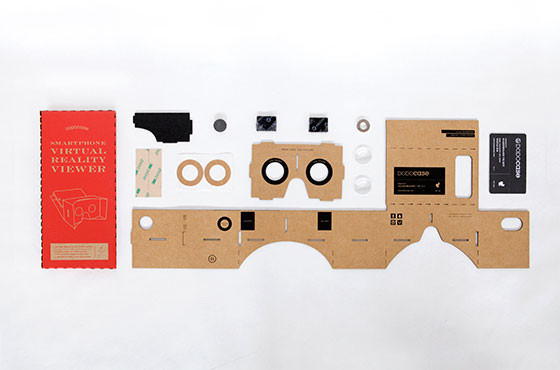
DODOcase was the first to market with a cardboard VR toolkit. Their cutout viewer was released so fast that Google barely had enough time to splice images of the DODOcase kit into their presentation at Google I/O. For a mere $25, anyone with a smartphone can purchase the toolkit and begin peering into the internet-connected metaverse. This has positioned DODOcase to become one of the quickest companies to capitalize on the exploding virtual reality trend. With this easily accessible device, the growth of the VR movement is bound to take off soon.
I interviewed [Craig Dalton], co-founder and CEO of DODOcase, at the biggest virtual reality event in Southern California’s history to date about the rise in the DIY VR developer community. This mini-conference was hosted by a local meetup group called VRLA and attracted over 600 people with a variety of virtual reality demos and presentations. I wrote about the whole event on Virtual Reality Reviewer’s website. [Craig] was happy to speak with us about how he thinks “the next million people to experience VR are going to experience it through one of these.” After seeing their kit and hearing what he had to say, we agree; especially if large corporations purchase a lot of them and hand them out to their employees and/or community members.
VR2GO
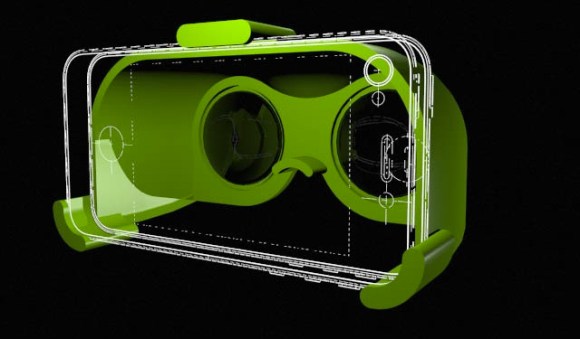
In the MxR Lab (where [Palmer Luckey] spun out of) a team of researchers led by [Mark Bolas] developed a lost-cost virtual reality solution that utilized the capabilities of a smartphone to allow the user to gaze into 3D generated worlds. On their website, they state that “these low-cost, lightweight systems can be used to create portable virtual reality applications for training, education, health and fitness, entertainment and more.”
The idea stemmed from an early foam board prototype called the FOV2GO, which was created in 2012. This was the device that [Palmer Luckey] was referring to when he called out Google on Reddit. I visited the legendary lab at the 2nd VRLA event a while ago and interviewed [Mark Bolas] about the role that technology has on the education of inner city kids. The first part of the video (1 of 4) can be seen embedded below. In it, [Mark] picks up one of the 3D printed VR2GO headsets. He also talks about how he wanted to have a Radioshack open 24/7, and now this lab is essentially that.
Interview with Virtual Reality pioneer Mark... by hackertrips
Other Smartphone Enabled Devices
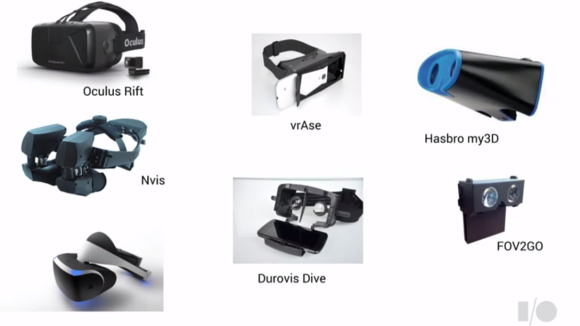
In Google’s VR presentation, they showcased some of the inspiration behind their cardboard design. Of those referenced was vrAse which raised over £66,000 on Kickstarter and went on to become a world leader in smartphone visualization devices. Hasbro even entered the virtual ring with their elongated, plastic 3D viewer specialized for the iPhone and iPod touch. A similar device called Nvis (which isn’t a smartphone viewer but has 2 hi-res microdisplays instead), a gaming-based viewer named Durovious Dive, and the FOV2GO were depicted as well.
Homemade Virtual Reality Goggles
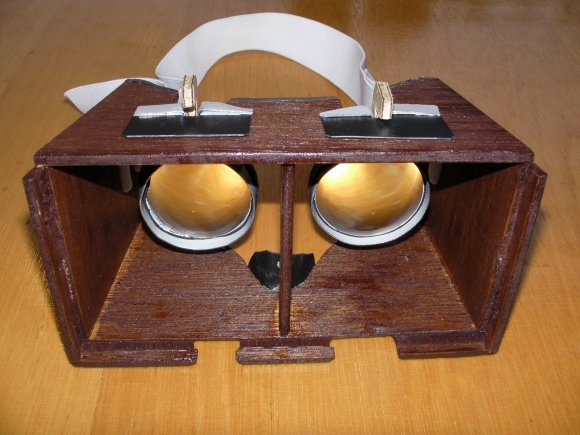
[Marcus] fashioned together a simple headset by 3D printing an enclosure and using two 50mm focal lenses. His design looks to have been created sometime in 2013, based on the link’s provide on his website (including a reference to the FOV2GO MxR device). The goggles are a little bit rough around the edges, which should be expected because of the time in which he was working. There were not a lot of readily available tutorials or materials then, so he had to make his own DIY 3D virtual reality goggles.
Going back even further, we found this head-mounted computer made of cardboard which we covered all the way back in 2009. This is probably the earliest iteration of a cardboard smartphone enabled VR viewer. The creator was named [Andrew] and managed to develop the device with a HTC Magic handset and a few dollars worth of ‘Harbor Freight crap.’ Of course fast forward to Google Cardboard and it only took about a week to see a DIY version of it.
Recently, Gadgetsin documented a way to produce a more durable virtual reality headset using Polycarbonate, which is also based on the Google cardboard design.

Conclusion
Despite the initial spark of virtual reality in the 1990’s, then it’s sudden decline, followed by the recent rise again, VR is here to stay. It shows no signs of slowing down. And with cheap, smartphone virtual reality toolkits like these, millions of early adopters will begin to explore the possibilities surrounding VR. The rapid growth of VR content will come from developers trying out their work on items similar to cardboard cutouts. The price is so low now that consumers will also start purchasing kits just to see what virtual reality is like.
For more information about the mobile VR viewer that brought virtual reality into the main stream, check out Google’s cardboard developer website and be sure to watch the full video below of them presenting the idea at I/O 2014.
[Thanks to William Correa for filming the interview with Mark Bolas!]















$25 for some cardboard, velcro, & plastic lenses? For something low-tech that costs less than $5 to manufacture, a retail price of $25 is a rip-off.
If $25 is too much for you then make your own, some people actually need a service like this it gives people choices and $25 is not a lot to most developers that can afford to own a smartphone.
Don’t care. Zero innovation. Desperately want to see them fail.
ganzuul – You sound like one of those Occupy Wall Street Retards, aka an Occutard.
Your desire to see a business fail is typical of an Obama Sheep.
It’s too much for me too!
If someone makes a clone for up to 10 USD (up to 5USD extra for shipping) I’m all in!
I want to be your customer! <3
(just don't rip me off!)
Chinese kits $11
Try $5 – http://www.tinydeal.com/diy-google-cardboard-vr-3d-glasses-for-iphone-samsung-cellphone-p-135220.html
If you’re too lazy or uncoordinated to assemble it, there’s a pre-built version for $7.50.
ITT: I expose my own session ID to a hacker community
Aside from that, you really can’t afford NOT to buy this.
No, you exposed your session ID to me and the spam filter.
http://img.photobucket.com/albums/v191/legofreak1988/Mobile%20Uploads/0716141915_zpsfc098329.jpg
I made one out of Lego using my nexus 7. I got the lenses from an old stereoscopic photo viewer.
LOL something about using our childhood legos to prototype tech toys is just so fantastic. I thought the purpose of lenses was to allow a more compact design? Do the stereo lenses allow/achieve that? The screen appear to be half a foot away.
the lenses are angled in a way to point your vision outwards a little bit. also to allow you to focus easily on something that close.
Google Cardboard wouldn’t run properly on my Asus HD7 tablet (something about wrong sensors?), it does run properly on my Samsung Galaxy S2 but the software wasn’t designed to handle various screen resolutions and so some of the display is chopped off :(
I can’t get the google software to install in my S2 – it tells me my phone is not compatible.
I know it’s old but it’s all I’ve got
Dave
i made mine with old glasses (just happened to be 3d glasses like from the movies)
cut holes in them,
stuck on lenses from a crappy pair of binoculars (i think small plastic magnifying glasses would do) with double stick foam
..i might use the box it came in if i want to attach it to a strap to wear around my head
I know I’m late, but I’d just lik to confim that using magnifiying glasses works a treat, that’s exactly what some friends and I did a couple of years ago. We had to make something using android to display 3d images for a school project. We came up with our take on vr glasses using two htc desires and two magnifying glasses. Of course it didn’t look as nice as the cardboard/3d-printed ones, since we used a construction helmet as a base and some balsa wood and isolation plates to hold everything in place, as you can see in the picture: http://pic.twitter.com/8XNMJv7x
Coming in late – but as far as whether VR will take off with the consumer is yet to be really known. The challenge isn’t the HMD part any longer (if it ever really was) – the real challenge is low-cost tracking hardware for the head and hands.
Initially, this will probably be done by a method similar to the current Rift DK2 – an in-bound looking camera tracking (the equivalent of) passive fiducial markers. This will be ok for simple head and hand tracking within the limited FOV of the camera, but a more advanced system will be needed once users realize they want to turn around, look over their shoulders, or do something else opposite the direction of the camera (you know, normal actions you would take in the actual world).
Hopefully, multiple in-bound looking cameras can be used and have a fast-enough framerate to keep up with the rest of the system. Such camera systems do currently exist as mocap solutions – but they aren’t meant to be used in a fast-action VR simulation – plus they are very expensive.
Other options are multi-sensor magnetic tracking solutions – such as those offered by Polhemous and Ascension; but again, both systems are extremely expensive, and not without their own problems. A notable recent consumer product in this sphere was the Razer Hydra 3D controller system – which unfortunately is no longer available.
I’m interested in what apps out there can be used with home brew goggles.
Other than cardboard all I’ve been able to play with are 3D YouTube videos.
When I try to run Cardboard I get told the demo file is missing, and I need 200MB of free space, I have more than this both internally and externally, anybody know how to fix this?
Same problem here … demo file appears to be missing. Any solutions so far?
10 years on from launching the A1, it’ll be interesting to see what vrAse launch this March with their A2…